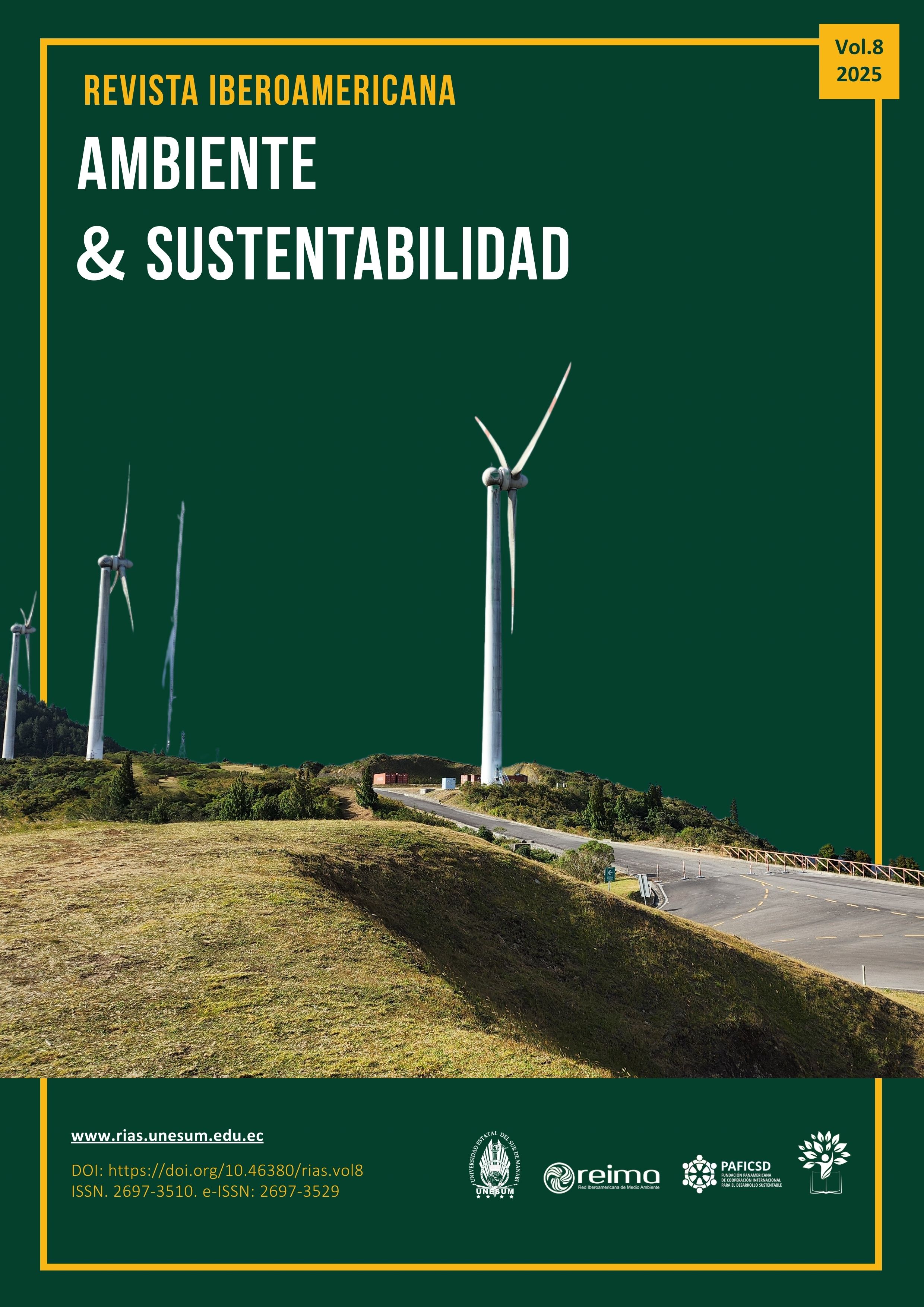Perspectivas multidimensionais sobre a morfologia de bairros periféricos em Tunja, Colombia
DOI:
https://doi.org/10.46380/rias.v8.e465Palavras-chave:
análise cartográfica, comunidades, participação comunitaria, planejamento territorial, sustentabilidade urbana, vulnerabilidade socialResumo
A pesquisa foi realizada em três bairros periféricos da cidade de Tunja (Altos de Cooservicios, Altamira e Santa Elena). Seu objetivo foi analisar as questões de caráter social, econômico e ecológico que afetam essas áreas, por meio de um levantamento cartográfico e de fichas específicas. A metodologia combinou análise planimétrica, visitas de campo, registros fotográficos e entrevistas informais, permitindo identificar fatores-chave, como acesso inadequado, invasão de espaços públicos e problemas de segurança. Técnicas descritivas e correlacionais foram aplicadas para examinar as relações entre as variáveis coletadas e priorizar as questões mais críticas. Os resultados mostram que as condições morfológicas e as características socioeconômicas de cada bairro estão fortemente ligadas aos níveis de vulnerabilidade observados, bem como à interação com os bairros vizinhos. Na discussão, destaca-se a importância de intervir de maneira diferenciada em cada bairro, considerando topografia, conectividade e participação comunitária para alcançar soluções mais eficazes e sustentáveis. Da mesma forma, enfatizam-se as implicações práticas dos achados. Por fim, as conclusões ressaltam a utilidade da metodologia proposta como uma ferramenta replicável em contextos urbanos semelhantes, além de seu potencial para orientar políticas públicas e estratégias de intervenção focadas nas necessidades das comunidades periféricas.
Downloads
Metrics
Referências
Alcaldía Mayor de Tunja. (2024). Delimitación de barrios y veredas. Departamento Administrativos de Planeación Territorial. https://acortar.link/MuL8RL
Alter, M. & Skinner, C. (2021). The Urban Informal Economy: Achieving Prospering and Territorial Equality. GOLD VI Working Paper Series 05. United Cities and Local Governments. https://acortar.link/HhmybQ
Calixto, R. (2024). Comportamiento de la movilidad vehicular en ciudades pequeñas. Estudio de caso: Tunja, Boyacá, Colombia. Revista Iberoamericana Ambiente & Sustentabilidad, 7, e372. https://doi.org/10.46380/rias.v7.e372
Calixto, R. (2025). Metodología para la evaluación de impactos ambientales causados por la fragmentación urbana [Tesis de doctorado no publicada]. Universidad Centro Panamericano de Estudios Superiores.
Córdova, M., Egas, A. y Menoscal, J. (2024). Asentamientos informales, regularización y riesgo de desastres en el periurbano del Distrito Metropolitano de Quito - Colinas del Norte. Cuadernos de Geografía: Revista Colombiana de Geografía, 33(1), 99–119. https://orcid.org/0000-0003-2570-3215
Cortés, Y. (2021). Spatial Accessibility to Local Public Services in an Unequal Place: An Analysis from Patterns of Residential Segregation in the Metropolitan Area of Santiago, Chile. Sustainability, 13(2), e442. https://doi.org/10.3390/su13020442
Mollashahi, H. & Szymura, M. (2022). Urban Ecosystem: An Interaction of Biological and Physical Components. An L. Hufnagel (Ed.), Biodiversity of Ecosystems. IntechOpen. https://acortar.link/qLsMRJ
Panzera, D. & Postiglione, P. (2021). The impact of regional inequality on economic growth: a spatial econometric approach. Regional Studies, 56(5), 687–702. https://acortar.link/p4WABg
Salem, M. & Tsurusaki, N. (2024). Impacts of Rapid Urban Expansion on Peri-Urban Landscapes in the Global South: Insights from Landscape Metrics in Greater Cairo. Sustainability, 16(6), e2316. https://doi.org/10.3390/su16062316
Santa, A. & Xiaofan, J. (2023). Rethinking walkability: Exploring the relationship between urban form and neighborhood social cohesion. Ciudades y sociedad sostenibles, 99, e104903. https://acortar.link/AjrPSA
Santamaría, L. (2022). Alternativa de movilidad para el borde noroccidental del Centro Histórico de Tunja. Revista Ciudades, Estados y Política, 9(2), 69-93. https://acortar.link/h95kJN
Santo-Tomás, R., Sáenz, C. & Rodríguez, E. (2020). Green Infrastructures in the Peri-Urban Landscape: Exploring Local Perception of Well-Being through ‘Go-Alongs’ and ‘Semi-Structured Interviews’. Sustainability, 12(17), 6836. https://doi.org/10.3390/su12176836
Smith, S., Bellaby, P. & Lindsay, S. (2010). Social Inclusion at Different Scales in the Urban Environment: Locating the Community to Empower. Urban Studies, 47(7), 1439-1457. https://doi.org/10.1177/0042098009353618
Soltani, S., Gu, N., Ochoa, J. & Sivam, A. (2021). The role of spatial configuration in moderating the relationship between social sustainability and urban density. Cities, 121, e103519.
https://doi.org/10.1016/j.cities.2021.103519
Subham, R., Suranjan, M., Arghadeep, Bo. & Indrajit, R. (2024). Mapping the vulnerable: A framework for analyzing urban social vulnerability and its societal impact. Societal Impacts, 3, e100049. https://doi.org/10.1016/j.socimp.2024.100049
Ursino, S., Vila, M. & Durante, M. (2023). Hábitat popular y organización comunitaria en barrios periféricos de Gran La Plata - Argentina ante COVID-19. Cuadernos de Vivienda y Urbanismo, 16. https://doi.org/10.11144/Javeriana.cvu16.hpoc
Publicado
Como Citar
Edição
Seção
Licença
Copyright (c) 2025 Rubén Dario Calixto Morales

Este trabalho está licenciado sob uma licença Creative Commons Attribution-NonCommercial-ShareAlike 4.0 International License.
Este trabalho está licenciado sob uma Licença Creative Commons Atribuição-NãoComercial-Compartilhamento pela mesma licença 4.0 Internacional (CC BY-NC-SA 4.0)
Esta licença permite que os usuários distribuam, remixem, adaptem e criem a partir do material em qualquer meio ou formato, desde que seja atribuída a autoria ao criador.














